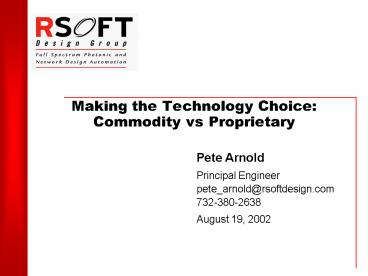Making the Technology Choice: Commodity vs Proprietary PowerPoint PPT Presentation
1 / 19
Title: Making the Technology Choice: Commodity vs Proprietary
1
Making the Technology ChoiceCommodity vs
Proprietary
2
Outline
- Baseline study characteristics, architecture and
methodology - Analysis methodology
- Baseline 802.11b results
- Sensitivity studies from 802.11b baseline The
4 Cs - Coverage
- Capacity
- CPE Cost
- Competition (market share)
- Technology variants
- Additional services
- Break-even results
- Conclusions
3
Baseline Study Characteristics
- Geographic Areas
- 100K population with 2 annual growth
- 50 mi2 suburban, 2000 mi2 rural
- Market Size and Growth
- Fisher-Pry (S-shaped) market growth, with 50
eventual market penetration and 5 year growth to
25 penetration - 25 market share, 10 churn per year
- Browsing Service
- 1 Mbps asynchronous 5 duty down, 1 duty up
- 35 per month 5 sessions/hr 100 seconds each
- IP Voice Service
- 16 kbps, no voice activity detection
- 10 per month 3 calls/hr 180 seconds each
- Additional Access Port Site expenses
- 20,000 one-time per site
- 10,000 per year per site (rental)
4
Baseline Architecture Technology
OC3 (155 Mbps) Up to 4 30,000 100/km
OC3 (5,000 100/mo)
- 802.11b Wireless Link
- Avg Throughput 2 Mbps
Point-to-Point Wireless 10 Mbps Shared
Capacity 10,000 100/mo
ISP 200/mo for 256 kbps
Router 100 Mbps Capacity, 8 Input Ports 10,000
100/mo
CPE Xmit Pwr 17 dBm Antenna Gain 10
dBi 250, 100 connect, 50 Equipment Recovery
Access Point Xmit Power 20 dBm
Antenna Gain 10 dBi 2,000
20/mo Channels (500 10/mo)
5
Analysis Methodology
- Establish 802.11b Baseline
- Investigate Sensitivity to
- Path Loss
- Capacity
- CPE Cost
- Market Share
- How about 5.8 GHz? Other technologies?
- Add IP Voice?
Build for Coverage
Expand for Capacity
Size and Cost Equipment
Generate Business Case Metrics
Create Summary Graphs
As a function of time
Calculations performed using WirelessSWAT for
WISPs
6
Baseline 802.11b Financial Results - Rural
- Large initial capital investment required due
to low subscriber density - coverage-limited deployment
- No further capital required for 8 years
- ROI 21.2, NPV of EBITDA 2.69M
7
Baseline 802.11b Study Results - Suburban
- More incremental capital investment as
deployment becomes - capacity-limited
- Significantly lower early capital investment
than for rural deployment - ROI 54.7, NPV of EBITDA 5.43M
8
Baseline 802.11b Study ResultsRisk vs Reward
- Rural deployment is coverage-limited during
most of study, - so takes longer to break even
- Same overall capital investment both
deployments serve the - same market size and both are eventually
capacity-limited - Break-even period 5.6 years for suburban, 8.9
years for rural
9
802.11b 2.4 GHz Baseline ROI NPV vs Excess
Path Loss (Coverage)
suburban
rural
- Suburban deployment is capacity-limited, rural
deployment is - coverage-limited except at low excess
path loss values - Successful rural deployment requires relatively
unobstructed paths - Suburban ROI is relatively insensitive to
excess path loss - ROI and NPV yield equivalent qualitative
conclusions
10
802.11b 2.4 GHz Baseline ROI NPV vs
Sectors/Access Point (Capacity)
suburban
rural
- Increased capacity at an Access Point is useful
in suburban - deployments, but not in rural deployments
- Note 3 or more sectors per Access point not
practical at 2.4 GHz, - due to insufficient spectrum
11
802.11b 2.4 GHz Baseline ROI vs CPE Cost
- Increased CPE cost is a significant contributor
to reduced ROI - in all deployments
12
802.11b 2.4 GHz Baseline ROI vs Purchased Link
Margin
suburban
rural
- CPE cost spent on additional link margin is
detrimental in the - capacity-limited suburban environment
- ROI is maximized in rural deployments by
moderate additional - CPE cost to improve link margin (here
around 75)
13
802.11b 2.4 GHz Baseline ROI vs Market Share
(Competition)
suburban
rural
- Increased market share in suburban deployments
increases absolute - returns, but does not significantly
increase ROI - Increased market share in rural deployments
significantly increases - both absolute returns and ROI
- Use of 2 sectors per Access Point significantly
increases ROI - except in rural deployments with low
market share
14
General 802.11b Financial Trends
- Excess path loss is more detrimental in rural
deployments - Additional capacity at an Access Point is more
useful in suburban deployments - CPE cost is a significant component of overall
business plan - Moderate CPE expenditure to increase link margin
is beneficial in rural deployments, but
detrimental in suburban deployments - Increased market share improves ROI only in rural
environments
15
802.11b at 5.8 GHzROI vs Sectors/Access Point
- Additional link margin has negative benefit in
suburban deployments - (capacity-limited design is unchanged,
but costs increase) - 5.8 GHz slightly inferior to 2.4 GHz unless
additional capacity per - Access Point is needed
16
High-Capacity 5.8 GHz TDD TechnologyROI vs
Market Share
- 7 Mbps in 10 MHz RF bandwidth 17 dBm
transmitter powers - 10 dBi antenna gains 6
sectors per Access Point - Optimized for high subscriber densities
- Moderate additional antenna gain can protect
against low achieved - market penetration
17
Adding Voice-over-IP Services
0
18
ROI Break-Even Period for Voice Data Data Only
19
Conclusions
- The viability of 802.11b depends very much on the
density of users to which the service is provided - CPE cost can be a controlling parameter but
minimizing it is not always the answer. Moderate
expenditure to increase link margin is justified
in rural environments - Sectorization is more beneficial in areas with
higher subscriber density - Use of 5.8 GHz is acceptable where capacity is
needed but range is not - IP voice can be a good plan to obtain additional
revenues from unused capacity and to reduce
break-even period - Proprietary technologies or 802.11b modifications
can help to address market and environment
variations - Combined engineering and business case analysis
should always be done prior to investing money

